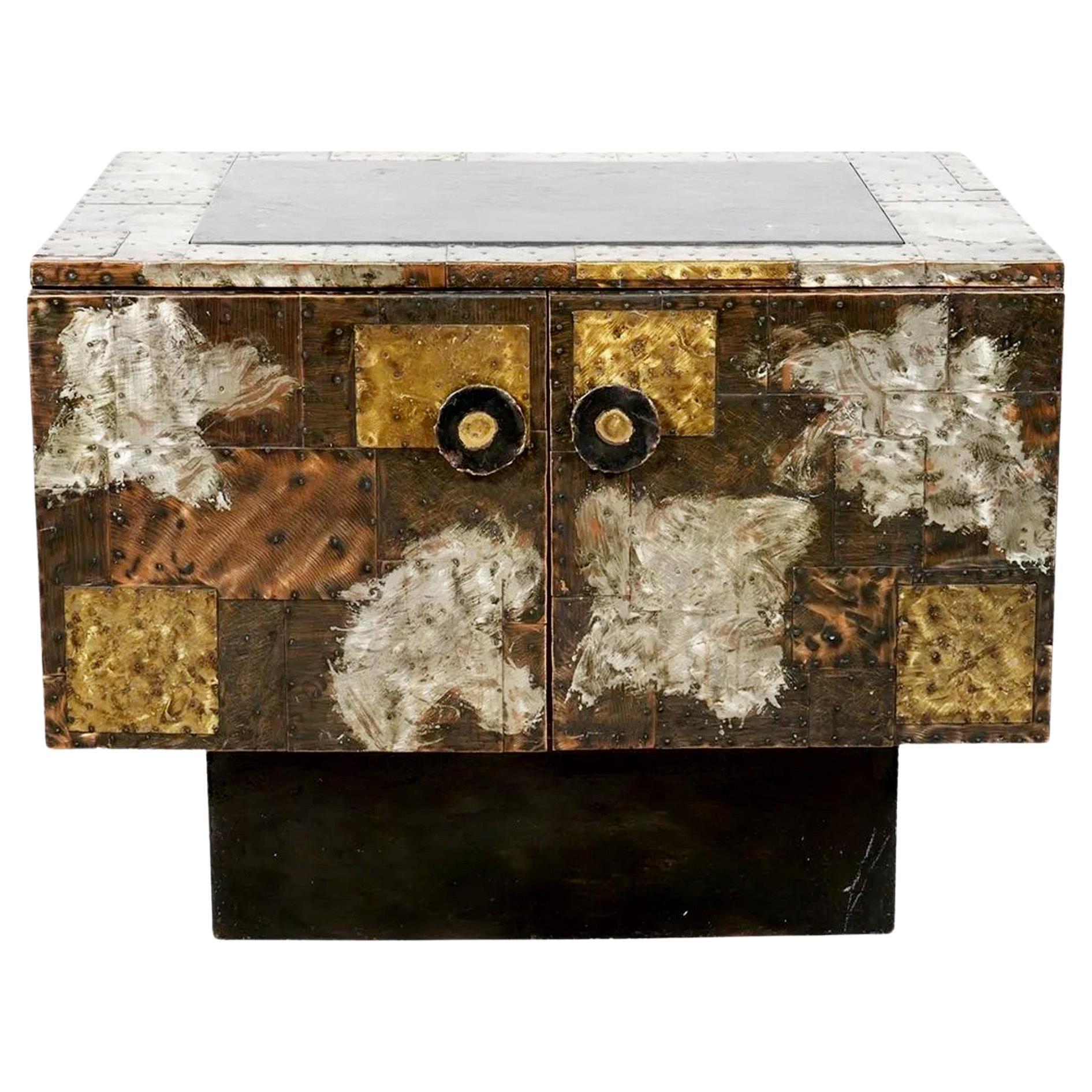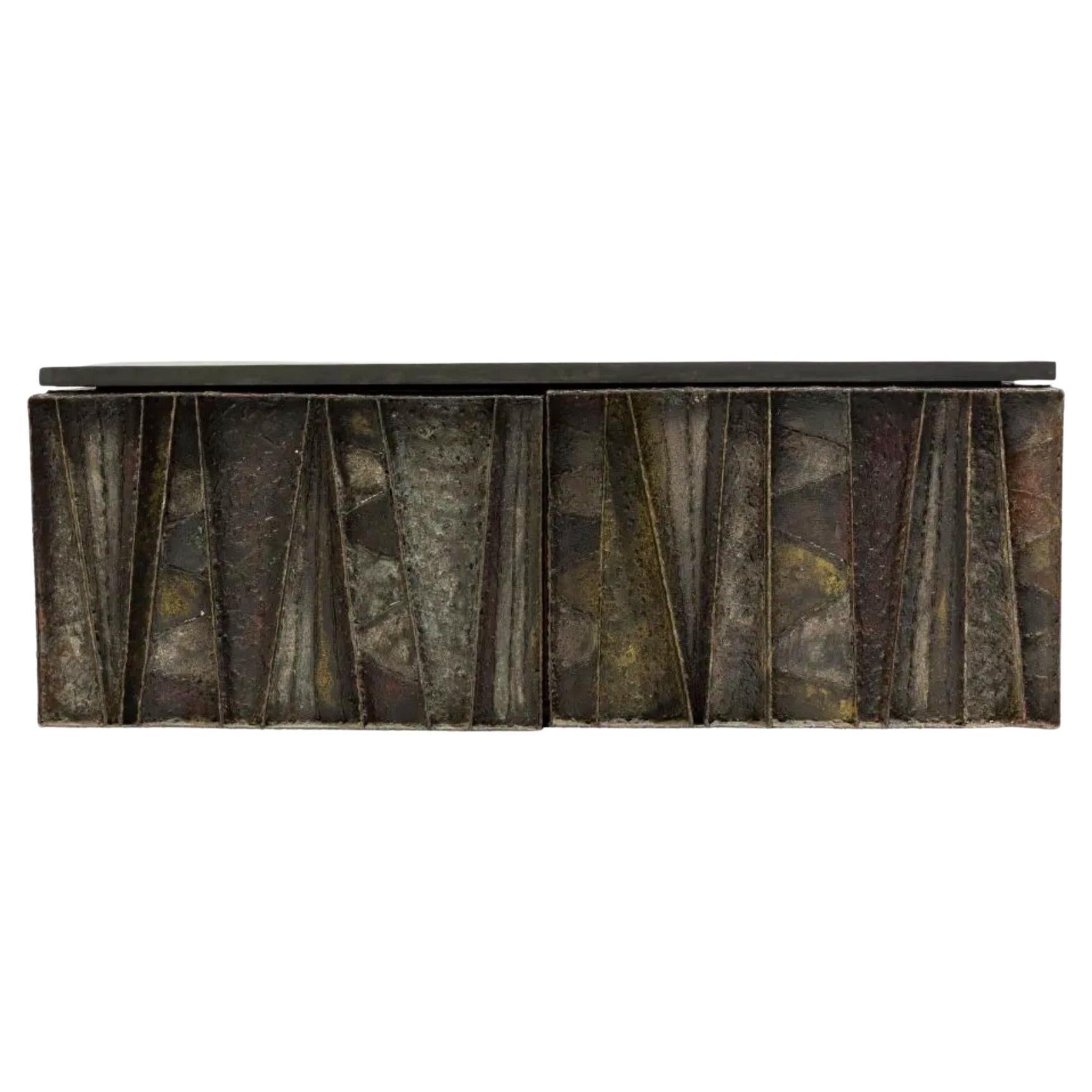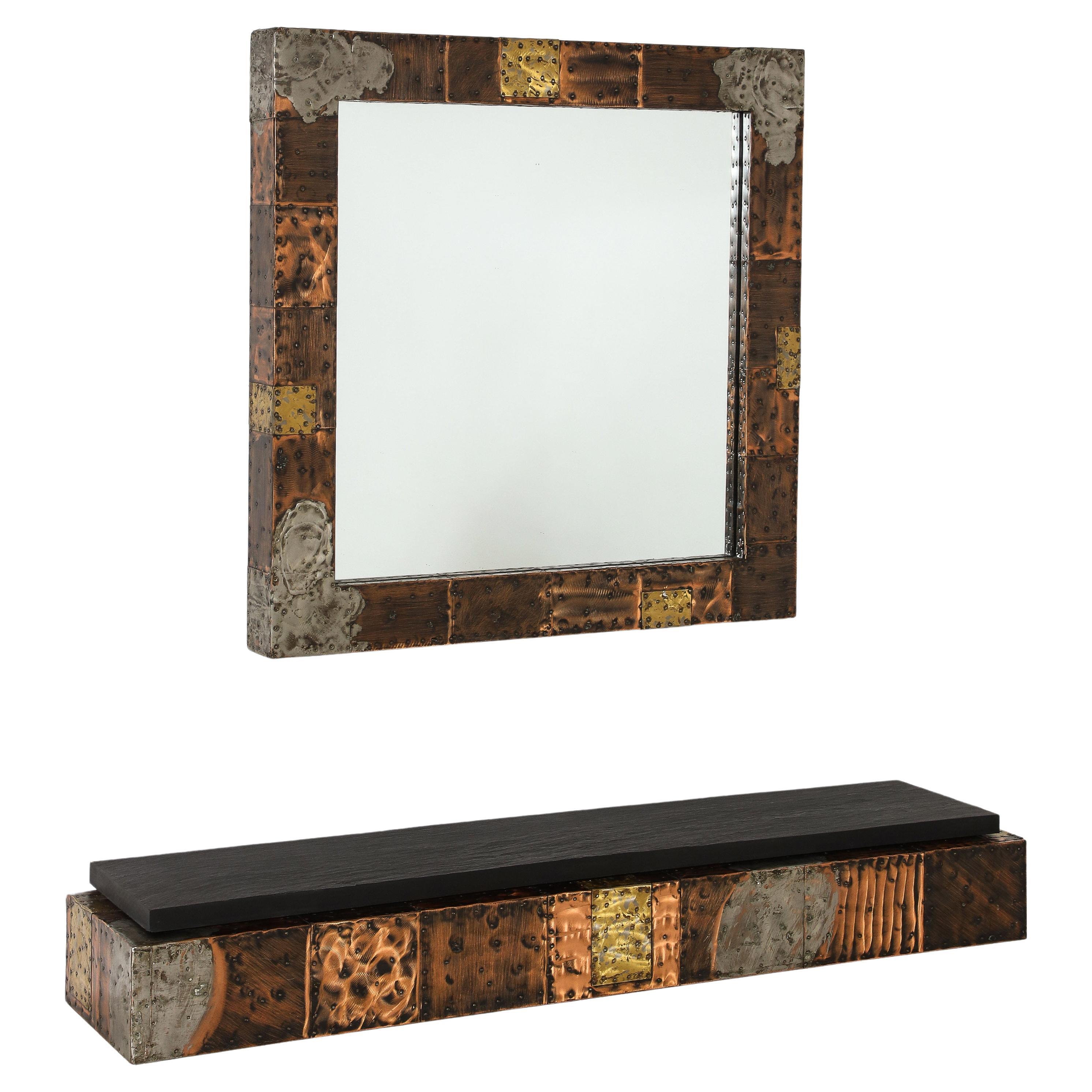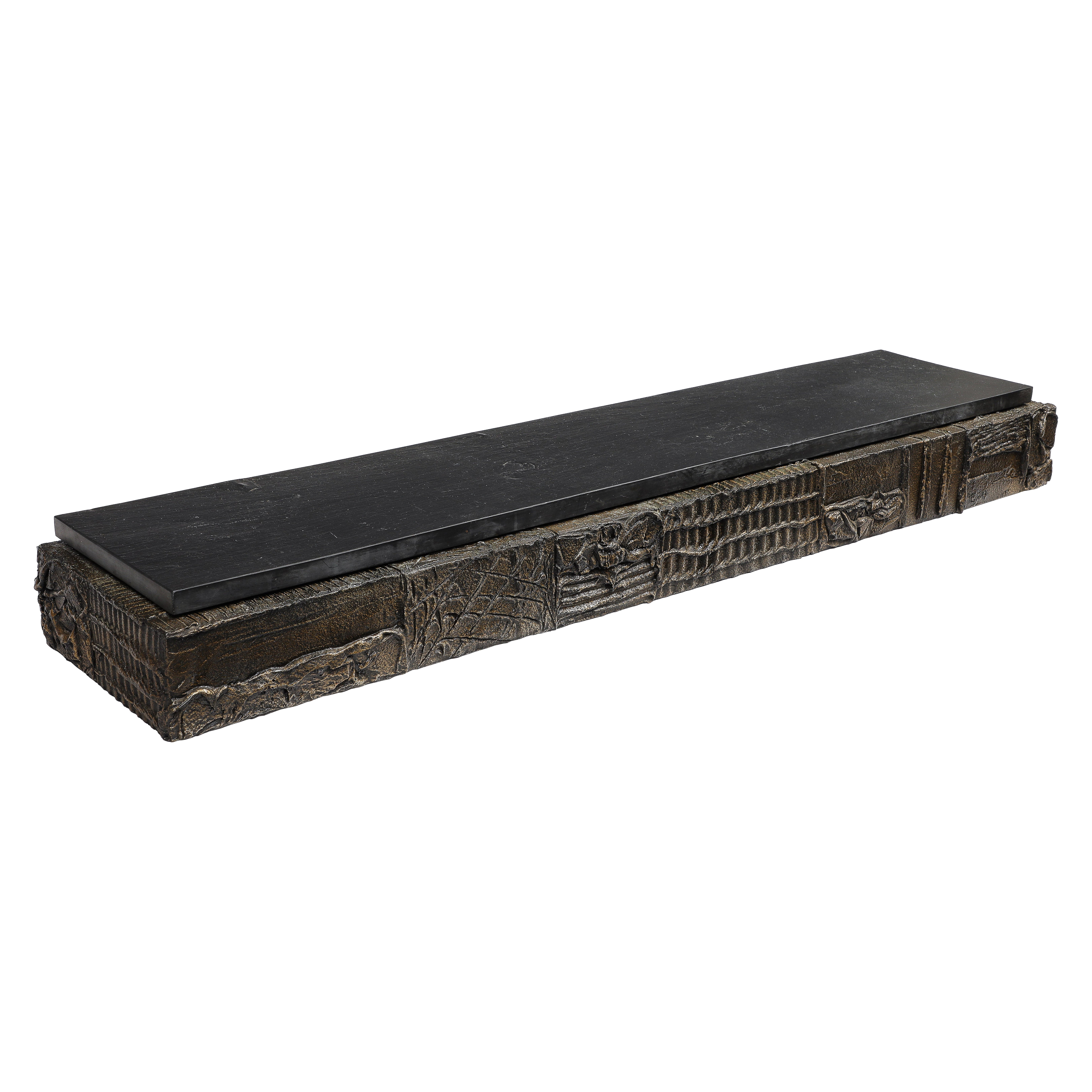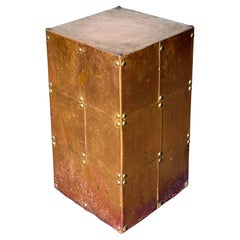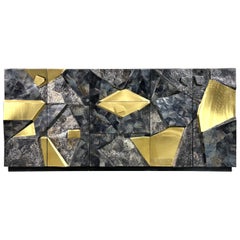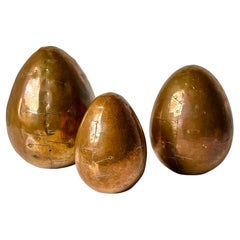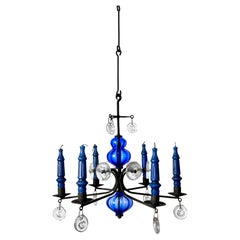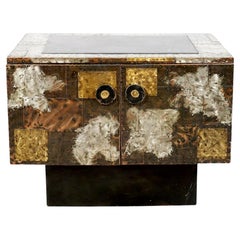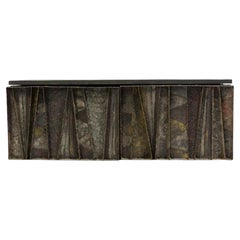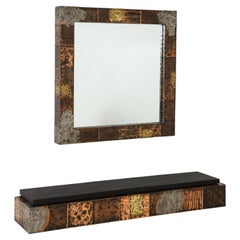Paul Evans Patchwork Copper Cabinet with Slate Top and Wall Hanging Mirror 1960s
About the Item
- Creator:Directional (Manufacturer),Paul Evans (Designer)
- Design:
- Dimensions:Height: 31 in (78.74 cm)Width: 48 in (121.92 cm)Depth: 20.5 in (52.07 cm)
- Sold As:Set of 2
- Style:Brutalist (Of the Period)
- Materials and Techniques:
- Place of Origin:
- Period:
- Date of Manufacture:circa 1968
- Condition:Wear consistent with age and use. Overall very well preserved condition with minimal surface wear. Mirror is in excellent condition. Small faint scratch to slate and use related wear to interior.
- Seller Location:Troy, MI
- Reference Number:1stDibs: LU8950244436792
Patchwork Cabinet
Sculptural and tastefully decorative, Paul Evans’s Patchwork cabinet is an audacious exploration of the several styles for which the furniture maker is known. A sideboard that Evans (1931–87) produced for Directional — a North Carolina furniture manufacturing company that became the catalyst for some of Evans’s most well-known designs — the cabinet’s clean lines and simple silhouette belie the maker’s mid-century influence, while its rough-hewn texture and traditional craftsmanship are nods to brutalism and the American Arts and Crafts movement. An enthusiastic and skilled metalworker, Evans produced the Patchwork collection, which essentially began as wooden boxes, with “patchwork” copper, brass and pewter coming together with nails. The series includes cabinets, sideboards, coffee tables and more.
The New Jersey-born Evans was raised in Pennsylvania, but he left in the 1950s for the Rochester Institute of Technology’s School for American Craftsmen in New York. Later, he ventured to the famed Cranbrook Academy of Art in Michigan, where he studied sculpture, metalwork, furniture design and jewelry-making. Evans found his way back to Pennsylvania, where he eventually began to collaborate with Directional, which produced his Cityscape, Sculpted Bronze, Argente and Patchwork furniture series. In addition to the cabinet, Evans created hundreds of pieces for the Patchwork line from 1964 through the 1970s. Each one is signed and dated, ensuring the authenticity of its handmade nature, a detail upon which the maker was insistent. These pieces, along with the rest of Evans’s work, are still in high demand and count a number of high-profile clients, from famous musicians to design enthusiasts, as collectors.
Paul Evans
A designer and sculptor, Paul Evans was a wild card of late 20th century modernism. A leading light of the American Studio Furniture movement, Evans’s sideboards, credenzas, coffee tables and other work manifests a singular aesthetic sense, as well as a seemingly contradictory appreciation for both folk art forms and for new materials and technologies.
Evans’s primary material was metal, not wood, which was favored by his fellow studio designers, and Bucks County, Pennsylvania, neighbors George Nakashima and Phillip Lloyd Powell. He trained in metallurgy and studied at the Cranbrook Academy of Art, the famed crucible of modern design and art in suburban Detroit. For a time early in his career, Evans also worked at Sturbridge Village, a historical “living museum” in Massachusetts, where he gave demonstrations as a costumed silversmith.
Evans’s earliest work unites these influences. The pieces that made his reputation are known as “sculpted-front” cabinets: wood cases faced with box-like high-relief patinated steel mounts laid out in a grid pattern. Each mount contains a metal emblem, or glyph, and the effect is that of a brawny quilt.
Evans’s later work falls into three distinct style groups. His sculpted-bronze pieces, begun in the mid-1960s, show Evans at his most expressive. He employed a technique in which resin is hand-shaped, and later sprayed with a metal coating, allowing for artistic nuance in the making of chairs, tables and case pieces. Later in the decade and into the 1970s, Evans produced his Argente series for celebrated manufacturer Directional (a brand known to vintage mid-century modern furniture collectors everywhere): consoles and other furniture forms that feature aluminum and pigment-infused metal surfaces welded into abstract organic forms and patterns.
Last, Evans's Cityscape design series — a milestone in the history of brutalist design — meshed perfectly with the sleek, “high tech” sensibility of the later ’70s. Evans constructed boxy forms and faced them with irregular mosaic patterns that mixed rectangular plaques of chromed steel, bronze or burlwood veneer. These, like all of Paul Evans’s designs, are both useful and eye-catching. But their appeal has another, more visceral quality: these pieces have clearly been touched by an artist’s hand.
Find a collection of authentic Paul Evans furniture today on 1stDibs.
- ShippingRetrieving quote...Shipping from: Troy, MI
- Return Policy
More From This Seller
View AllVintage 1970s Mid-Century Modern Pedestals
Brass, Copper
Late 20th Century Mid-Century Modern Credenzas
Stone, Brass
1990s Brutalist Figurative Sculptures
Brass, Copper
Vintage 1960s Swedish Mid-Century Modern Chandeliers and Pendants
Wrought Iron
Late 20th Century American Post-Modern Wall-mounted Sculptures
Mirror, Wood
Mid-20th Century Mid-Century Modern Wall-mounted Sculptures
Brass, Enamel
You May Also Like
Vintage 1960s American Brutalist Cabinets
Brass, Copper, Pewter
Vintage 1960s American Brutalist Cabinets
Slate, Steel
Vintage 1960s American Mid-Century Modern Cabinets
Slate
Mid-20th Century American Brutalist Shelves
Slate, Brass, Copper, Steel
Vintage 1960s American Mid-Century Modern Cabinets
Brass, Copper, Steel
Vintage 1960s American Mid-Century Modern Shelves
Slate, Bronze
